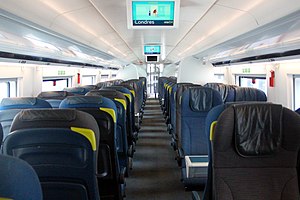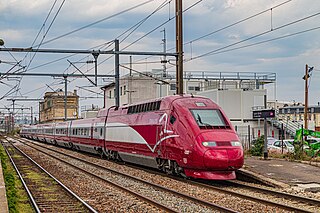
Eurostar is an international high-speed rail service in Western Europe, connecting Belgium, France, Germany, the Netherlands and the United Kingdom.

High Speed 1 (HS1), legally the Channel Tunnel Rail Link (CTRL), is a 109.9-kilometre (68.3-mile) high-speed railway linking London with the Channel Tunnel.
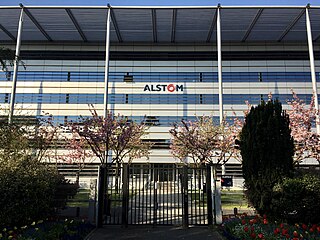
Alstom SA is a French multinational rolling stock manufacturer which operates worldwide in rail transport markets. It is active in the fields of passenger transportation, signaling, and locomotives, producing high-speed, suburban, regional and urban trains along with trams.
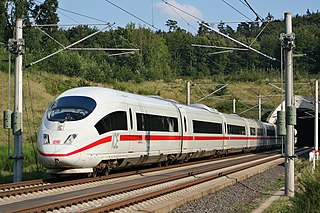
Intercity Express is a high-speed rail system in Germany. It also serves destinations in Austria, France, Belgium, Switzerland and the Netherlands as part of cross-border services. It is the flagship of the German state railway, Deutsche Bahn. ICE fares are fixed for station-to-station connections, on the grounds that the trains have a higher level of comfort. Travelling at speeds up to 320 km/h (200 mph), they are aimed at business travellers and long-distance commuters and marketed by Deutsche Bahn as an alternative to flights.

St Pancras railway station, officially known since 2007 as London St Pancras International, is a major central London railway terminus on Euston Road in the London Borough of Camden. It is the terminus for Eurostar services from Belgium, France and the Netherlands to London. It provides East Midlands Railway services to Leicester, Corby, Derby, Sheffield and Nottingham on the Midland Main Line, Southeastern high-speed trains to Kent via Ebbsfleet International and Ashford International, and Thameslink cross-London services to Bedford, Cambridge, Peterborough, Brighton, Horsham and Gatwick Airport. It stands between the British Library, the Regent's Canal and London King's Cross railway station, with which it shares a London Underground station, King's Cross St Pancras.

Alta Velocidad Española (AVE) is a high-speed rail service operated by Renfe, the Spanish State railway company.

The Ligne à Grande Vitesse Nord, typically shortened to LGV Nord, is a French 333-kilometre (207 mi)-long high-speed rail line, opened in 1993, that connects Paris to the Belgian border and the Channel Tunnel via Lille.

The Chatham Main Line is a railway line in England that links London Victoria and Dover Priory / Ramsgate, travelling via Medway.

Ashford International railway station is a National Rail station in Ashford, Kent, England. It connects several railway lines, including High Speed 1 and the South Eastern Main Line. Services are operated by Southeastern and Southern.
Eurostar International Limited (EIL) is the railway company operating the international Eurostar train services between Paris, London, Amsterdam and Brussels via the Channel Tunnel. Eurostar was previously operated by three separate companies in Belgium, France and the United Kingdom, but this structure was replaced by EIL as a new single management company on 1 September 2010. EIL is owned by Eurostar Group.

London and Continental Railways (LCR) is a property development company owned by the Government of the United Kingdom for developing former railway land. The company was originally established in 1994 as a private consortium to own European Passenger Services and build the Channel Tunnel Rail Link (CTRL) under a contract agreed with the government.

Siemens Velaro is a family of high-speed electric multiple unit trains built by Siemens and used in Germany, Belgium, France, the United Kingdom, the Netherlands, Spain, China, Russia, and Turkey. The Velaro is based on the ICE 3M/F high-speed trains manufactured by Siemens for Deutsche Bahn (DB). Deutsche Bahn were the first to order Siemens high-speed trains; it ordered 13 of these units in 1994, the Nederlandse Spoorwegen (NS) 4 units. The trains were delivered in 1999 for service and were labeled and marketed as the Velaro by their manufacturer, Siemens.

Manchester International Depot is a train maintenance depot in Manchester, England. It was constructed next to Longsight depot in the early 1990s as part of a plan to operate Regional Eurostar international train services from Manchester to Europe via the Channel Tunnel.
The Nightstar was a proposed overnight sleeper train service from various parts of the United Kingdom to destinations in mainland Europe, via the Channel Tunnel, in the mid 1990s. To run alongside the Eurostar, and north of London day-time Regional Eurostar services which were never operational, the Nightstar was the last part in a proposed round-the-clock passenger train utilisation of the Channel Tunnel.
Siemens Mobility is a division of Siemens. With its global headquarters in Munich, Siemens Mobility has four core business units: Mobility Management, dedicated to rail technology and intelligent traffic systems, Railway Electrification, Rolling Stock, and Customer Services.

ICE 3, also know as Intercity-Express 3, is a family of high-speed electric multiple unit trains operated by Deutsche Bahn. It includes classes 403, 406,407 and 408, which are known as ICE 3, ICE 3M, New ICE 3 and ICE 3neo respectively. Three multisystem trains, known as ICE International, are owned by Nederlandse Spoorwegen. Based on the ICE 3M/F, Siemens developed its Siemens Velaro train family with versions used in Germany, Belgium, France, the United Kingdom, the Netherlands, Spain, China, Russia and Turkey. ICE 3 trains have a maximum speed of 320 km/h (200 mph) when travelling on the high-speed rail lines, however class 403 are permitted to go up to a maximum speed of 330 km/h (210 mph) when it travels on the high-speed route between Frankfurt and Cologne.
The Channel Tunnel Safety Authority is an international regulatory body responsible for safety in the Channel Tunnel.
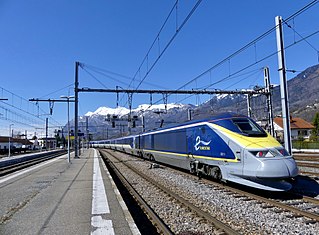
The British Rail Class 373, known in France as the TGV TMST and branded by Eurostar as the Eurostar e300, is a French designed and Anglo-French built electric multiple unit train that was used for Eurostar international high-speed rail services from the United Kingdom to France and Belgium through the Channel Tunnel. Part of the TGV family, it was built with a smaller cross-section to fit the smaller loading gauge in Britain, was originally capable of operating on the UK third rail network, and has extensive fireproofing in case of fire in the tunnel. It is both the second longest—387 metres —and second fastest train in regular UK passenger service, operating at speeds of up to 300 kilometres per hour (186 mph).

Nomad Digital is an Internet Protocol (IP) Connectivity provider to the transport sector. It deploys wireless broadband connections for trains, metros, trams and buses, including passenger Wi-Fi services and remote condition monitoring for on-board rail components. Headquartered in Newcastle upon Tyne in England, it operates globally.
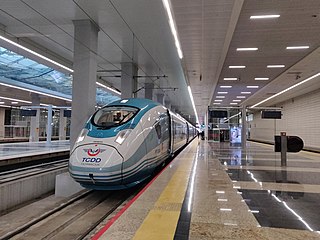
TCDD HT80000, also known as Siemens Velaro TR, is a series of high-speed electric multiple units built by Siemens for the Turkish State Railways. The EMUs are used for the Yüksek Hızlı Tren (YHT) services on the Turkish high-speed railway network and especially on the Polatlı–Konya high-speed railway, where they can reach a maximum speed of 300 km/h (186 mph).

